| Please note that these pages are from our old (pre-2010) website; the presentation of these pages may now appear outdated and may not always comply with current accessibility guidelines. |
| Please note that these pages are from our old (pre-2010) website; the presentation of these pages may now appear outdated and may not always comply with current accessibility guidelines. |
Embroidered Bible
 |
| The book of the month for June is a Geneva Bible dating from 1633 in a beautiful embroidered binding. This version of the Bible was originally translated by Protestants who had fled from Catholic persecution during the reign of Mary Tudor. Also bound with this copy are the Psalms of David in Scots Meter, published in Edinburgh in 1632. |
|
Opening of the Book of Genesis showing the use of marginal notes, numbered verses and an 'argument' at the start of the book and chapter. |
During the reign of the Catholic Mary Tudor (1553-8) many English Protestants were charged with heresy and executed. Amongst those sentenced to death by burning were individuals associated with Bible translation such as Thomas Cramner and John Rogers. Many fled from this persecution into exile and a significant number settled in Geneva. This was a centre for radical Protestantism and home to Calvin, one of the most important and influential theologians of this doctrine. The exiled English community in the city had as many as two hundred members at this time. With such a strong Protestant position, Geneva became a centre for Bible study and under the guidance of William Whittingham, a new translation of the Bible was undertaken. The Geneva Bible that was produced used several devices to help the reader to study, understand and interpret the Bible. Translated from the original Hebrew and Greek texts, the script was divided into numbered verses for the first time. An 'argument' was also used before each book and chapter to help explain the meaning of the words. Also of importance were the marginal notes, thought to amount to 300,000 words or about a third of the complete length of the Bible. The translators used these scholarly annotations to inform the reader about the original script, to clarify ambiguous meanings and for cross-referencing. However, King James and the political and religious authorities of the seventeenth century were suspicious of these marginal annotations, believing that they encouraged sedition. Indeed, James claimed that some notes were 'very partial, untrue, seditious, and savouring too much of dangerous and traitorous conceits.' His attitude is perhaps unsurprising when notes such as Exodus 1:19 claimed that a disobedient act against a king was lawful. This passage told of how the Egyptian King commanded the Hebrew midwives to kill any male children that were born to the Israelites. The midwives, fearing God, defied the king and saved the male children. When called before the king they then lied about what they had done. In response to this passage the marginal note stated that 'Their disobedience herein was lawfull, but their dissembling evil.' This note which justified the defiance of a monarch's command, would clearly have been objectionable to a king who believed in absolute royal authority.
|
| Despite this royal antipathy, the Geneva Bible was very popular, often being described as the 'Bible of the people'. It was not used in the Church of England as the notes were sometimes too Protestant for the moderate Elizabethan religious settlement. However, it was used in the Scottish Kirk. Indeed, in 1579 a Scottish edition of the Geneva version was the first Bible to be printed in Scotland. According to Darlow and Moule, between 1560 and 1644 at least 140 editions of the Geneva Bible or Testament appeared. It was the Bible of Shakespeare and as late as 1643, Cromwell's New Model Army was carrying the Soldier's Pocket Bible made up of extracts from the Geneva version. This popularity meant that the King James Authorised Version, first published in 1611, took a long time to become established. This copy of the Geneva Bible has an embroidered binding with a lion motif. In the sixteenth and seventeenth centuries it became popular to bind books in textiles such as canvas, satin or velvet. Usually applied to devotional texts such as Bibles or Psalters, embroidered bindings were not produced on a large scale, but made as separate commissions. The embroidery did not form part of the structure of the book binding itself. It was normally made separately, often by a professional embroiderer, before being stitched or stuck onto the boards of a book that had already been bound. The designs were taken from pattern books made especially for embroiderers and often included biblical figures, coats of arms and initials, heraldic designs and emblems. If you would like to find out more about embroidered bindings, the British library has an interesting online guide which provides background information as well as suggestions for further reading. |
Detail of the beautiful embroidered binding showing the lion motif. |
|
Detail of the false imprint, in a heart-shaped frame, taken from the engraved title page.
|
|
||
|
'The woodcut border to the first general title is a frame having twenty-four small compartments, showing on the left - the tents of the twelve tribes; on the right - figures of the twelve Apostles; the inner part exhibits the four Evangelists, with the symbols of the dove and the Agnus Dei, and a lamp, and two open books inscribed Verbum Dej Manet in Aeternum; the letterpress of the title is enclosed within a heart-shaped frame in the centre; at the base of the cut is a line of music. The same border is used for the NT [New Testament] title' The false pages claim that the Bible was published by Christopher Barker, 'Printer to the Queens most Excellent Majesty', in 1599. However, another imprint at the end of the Bible reveals that it was actually printed in Amsterdam in 1633. The use of false title pages crediting the work to an authorised printer at an earlier date, suggests that this Bible was illegal or controversial. |
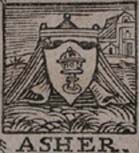 |
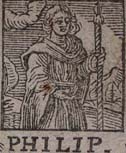 |
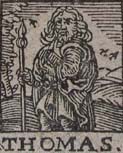 |
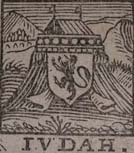 |
| Detail from the engraved title page showing Saint
Thomas and Saint Philip and the tribal tents of Asher and Judah. |
|
The main title page. |
This edition was certainly produced outside the monopoly of the Stationers Company. The right to print Bibles in England belonged to the King's Printer, Robert Barker, son of Christopher Barker. Cambridge University Press also claimed this privilege. Despite the fact that unlicensed foreign texts infringed this monopoly, imported material had a sizeable share of the English and Scottish book market in the seventeenth century. Although viewed by some as a threat to the English printing industry, Sprunger has suggested that many booksellers were willing to stock imported Bibles. Unlike much of the radical and inflammatory literature that was unlawfully brought into the country, the Bibles were only illegal because they infringed these monopoly patents. The false title pages helped the Bibles to appear legitimate and licensed so they could blend in with other books in the shop. It is also noteworthy that the false imprint dates to the reign of Elizabeth I when Geneva Bibles were less controversial. The general religious and political climate of the 1630s was moving towards conformity and censorship, with the monarchy trying to exercise control over the printing press. The importation of Geneva Bibles with their objectionable and arguably seditious notes, along with other extreme Protestant literature, challenged this control. |
Detail from the main title page depicting the crossing of the red sea. |
|
The contents page of the Bible. |
The illegal transportation of books into the country was certainly monitored by the authorities. Christopher Hill has made some interesting observations about this in his work The English Bible and the Seventeenth Century Revolution. He draws attention to a report made by the ambassador to the Netherlands, Sir William Boswell, in 1633. It stated that amongst other subversive texts unlawfully smuggled from Amsterdam to London were 'two impressions lately of the Bible with Geneva notes,' including one with a false title page. In 1632 a man was jailed for importing such Geneva Bibles. Archbishops continuously objected to these unlicensed books being shipped into the country by merchants and sailors looking to make profits from devotional texts. Indeed, William Laud, Archbishop of Canterbury from 1633-45, admitted that he had suppressed the Geneva Bible during his time in office. Laud persecuted extreme Protestants, known as Puritans, and other religious dissenters during his primacy. This ultimately led to his execution by the House of Commons in 1645. At his trial, Laud stated that he had suppressed this version not only because of the controversial marginal notes but also because he was trying to protect the economic position of English printers. It is probable therefore that the establishment objected to the importation of the Geneva Bible on both economic and religious grounds, thus necessitating the use of false title pages. The real imprint for this work, which confirms that the book was printed in Amsterdam in 1633, can be found at the end of the Bible. At this time Amsterdam was a place of comparative intellectual and religious freedom. It was also an important centre for trade and finance. The printing houses played a vital role in both the commercial and intellectual life of this city.
|
|
Detail showing the real imprint for the Bible. |
Thomas Crafoorth (Crafford) (fl 1604-49) who commissioned this Bible, was an important editor and publisher in Amsterdam. Originally from Reading, Crafford was a religious separatist and merchant. He was also known for being a libeller and for going bankrupt. In 1633 he contracted the printer J.F.Stam to produce this edition. They went on to re-publish it in 1642 and 1644. As well as printing religious texts, Crafford also produced radical literature. In 1649 he was banished from Amsterdam for being a 'libeller' and 'vagabond'. Sprunger believes that Crafford probably had the rather unfortunate distinction of being taken to court and sometimes imprisoned more than any other contemporary Englishman who was living in the city. |
| Joris Veseler (1589-1624) and his successor John Frederick Stam (1602-1667) were established printers in Amsterdam. Veseler was amongst the first printers in the city to target the English book market. Stam 'of Gouda' married Veseler's widow in 1628 and took over the business 'by the South-Church.' After a few years he had become one of the leading printers of English texts in the Netherlands, mainly producing Bibles. As we have seen, these were generally printed with false title pages which credited the printing to Barker. |
Detail of a woodcut at the end of the Bible. |
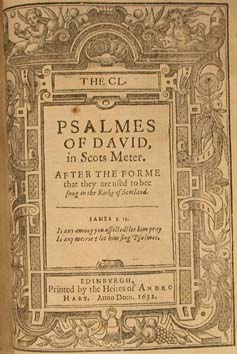 The title page for the Psalms of David in Scots Meter. |
Bound with this Geneva
Bible are the Psalms of David in Scots Meter. This edition was
printed by John Hart, the son of Andro Hart, along with his stepmother Jonet
Hart and his brother Samuel as the 'Heires of Andro Hart' at Edinburgh in
1632.
As hymns were not used in English or Scottish church services in the sixteenth and seventeenth centuries, psalms were an important way for the congregation to participate in worship. The Scottish Psalter, based in part on the versification of Sternhold and Hopkins, was published in 1564 and remained the standard in the Scottish Kirk until 1650 . In the 1630s attempts were made by Charles I to introduce his father King James' Psalter into Scotland. This was an unsuccessful and unpopular move that was viewed as part of a wider programme of English interference in the Scottish Kirk. Hostility towards the Psalter became part of a broader movement which grew in strength throughout the 1630s as Charles I added a Book of Canons and a Prayer book to the Psalter. The fact that the traditional psalms have been bound with the Geneva Bible to make up this book suggests that whoever owned and bound it was out of kilter with the religious policies of the crown. It is probable that a conformist at this time would have owned a King James Version of the Bible with the King James Psalter, not a controversial Bible with an established book of Psalms that the crown was trying to replace.
|
|
The Bible in the protective wooden box. |
This Bible is stored in
a protective wooden box. Throughout the Medieval and Renaissance periods,
people attached great significance to books. Sacred works such as Bibles
were particularly cherished and were often handed down from generation to
generation. A Bible might often have been the only book owned by a family.
Books were often kept in boxes and many Bibles that
have been stored this way survive to this day.
This Bible also comes with a piece of cloth in the same embroidered style as the binding of the Bible, with red ribbons attached to each corner. Although the function of this cloth is unknown it was possibly used as some sort of protective covering or mat. This Bible is part of the Euing Collection, donated to the University in the nineteenth century by William Euing (1788-1874), a Glasgow insurance broker. His collection is divided into three collections consisting of general works, early printed music and 3,000 volumes of devotional texts including 24 incunabula. The rich and varied collection of Bibles, Psalters and Prayer books, includes many different editions in various languages. It is a fantastic resource for anyone interested in Biblical and Religious Printing.
|
The Bible with the embroidered cloth. |
Also of interest:The following were invaluable in compiling this article: |
|
Return to main Special Collections
Exhibition Page Emily Wood (Graduate Trainee), June 2006
|